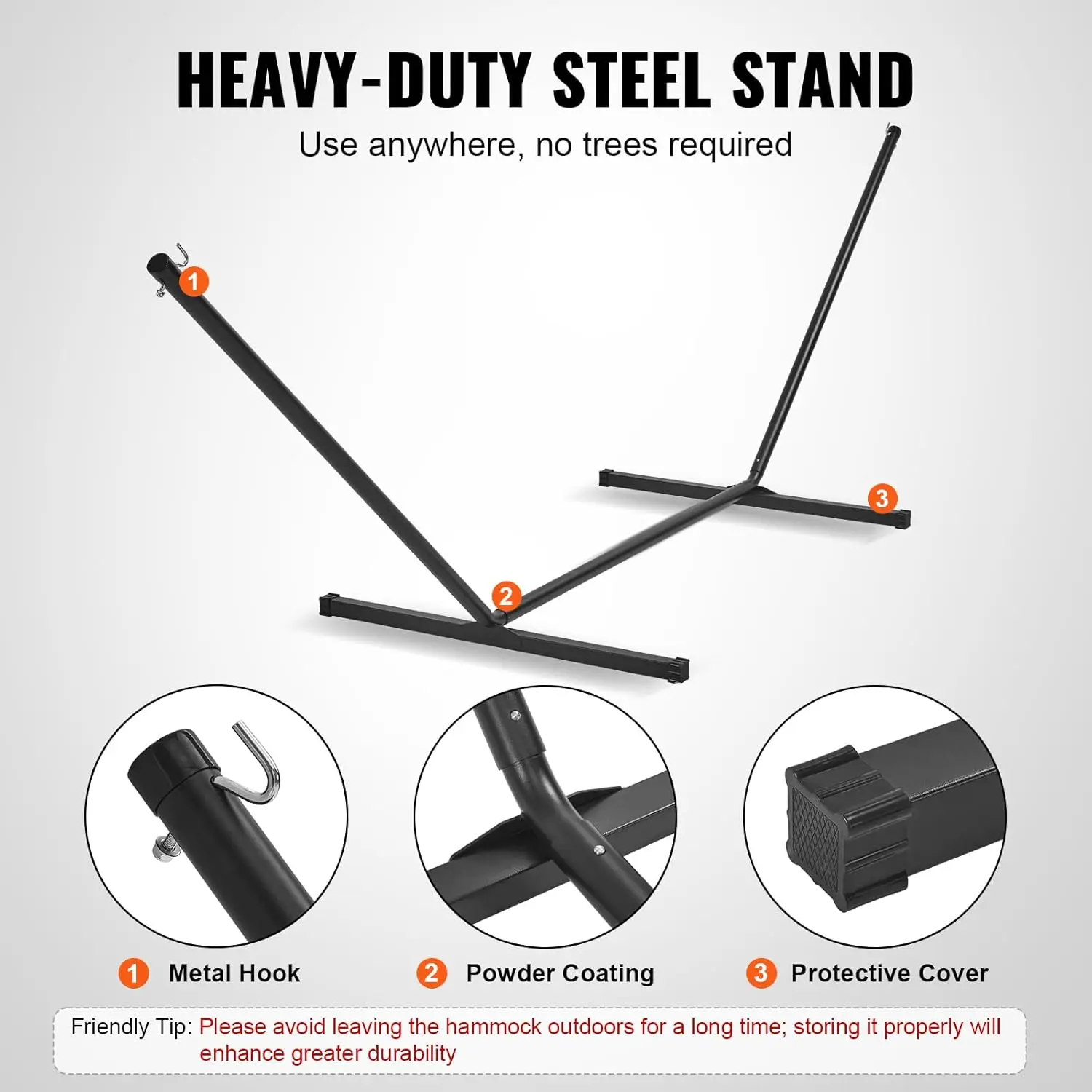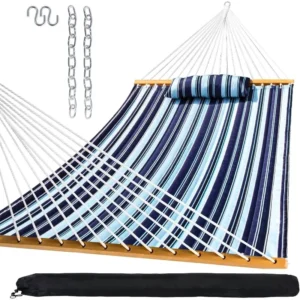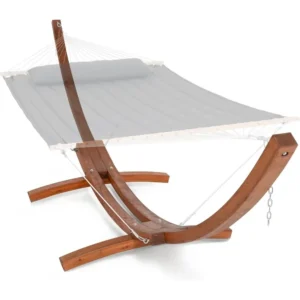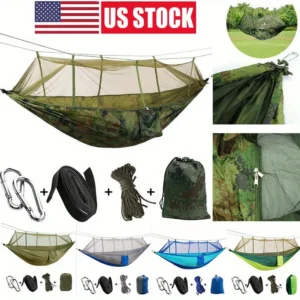Understanding the Cold Challenges of Hammock Camping
When you venture into the outdoors with a hammock, you might discover what experienced campers call “cold butt syndrome” – that uncomfortable chill that creeps in from beneath, even when the air temperature doesn’t feel particularly cold. This happens because hammocks, by design, expose more of your body’s surface area to the elements than ground sleeping.
There are four primary types of heat loss that affect hammock campers:
- Convective heat loss: Air moving around and beneath your hammock carries away body heat
- Conductive heat loss: Direct contact with cold surfaces (like the hammock fabric) pulls heat away
- Radiative heat loss: Your body naturally emits heat into the surrounding environment
- Evaporative heat loss: Moisture from perspiration or humidity causes cooling as it evaporates
Traditional sleeping bags often fail in hammocks because the insulation underneath your body gets compressed by your weight. When insulation compresses, the air pockets that trap warmth are eliminated, leaving just a thin layer of fabric between you and the cold air below.
Understanding these principles isn’t just interesting science – it’s essential for comfortable hammock camping. The temperature difference between your body (around 98.6°F/37°C) and nighttime air (which can drop 20°F/11°C or more from daytime temperatures) creates significant heat transfer that must be addressed for comfortable sleep.
Proper indoor outdoor hammock placement can help mitigate some environmental factors, but in outdoor settings, you’ll need specific insulation strategies to combat these heat loss challenges. Many campers are surprised to discover that they need insulation in hammocks even when temperatures are in the 60s°F (15-20°C), especially if there’s any breeze present.
Choosing between indoor vs outdoor hammocks becomes particularly important when considering warmth needs, as outdoor models need to address these thermal challenges more comprehensively.
The Science Behind Quilted Insulation: Trapping Air for Warmth
At the heart of quilted hammock insulation is a simple but powerful scientific principle: still air is one of nature’s best insulators. This is the same principle that makes down jackets, sleeping bags, and home insulation effective. When air is trapped and prevented from circulating, it creates a thermal barrier that slows heat transfer away from your body.
Quilting creates a three-dimensional structure within the fabric that establishes and maintains stable pockets of air. The quilting pattern – typically a series of sewn channels, baffles, or chambers – prevents the insulation material from shifting or bunching. This ensures consistent coverage without cold spots.
The concept of “loft” is crucial in understanding insulation effectiveness. Loft refers to the thickness or height of the insulation when it’s allowed to fully expand. Higher loft means more trapped air, which generally translates to better insulation. When insulation is compressed (like when you lie on top of it), the loft collapses, and much of the insulating power is lost. This is why underquilts that hang beneath the hammock rather than being compressed beneath you are so effective.
The physics of heat transfer through still versus moving air explains why quilted hammocks work so well. Moving air (like wind or convective currents) quickly carries heat away from your body. Still air, however, is approximately 25 times less conductive than moving air, creating a remarkably effective barrier when properly trapped within quilted layers.
Different quilting patterns affect performance too. Vertical baffles tend to prevent insulation from shifting sideways, while horizontal baffles prevent downward migration. Diamond patterns and box-baffled construction provide excellent three-dimensional stability that maintains even insulation distribution across the entire surface.
Our quilted fabric hammock sets employ these scientific principles to create hammock systems that effectively retain body heat even in challenging outdoor conditions.
The Complete Hammock Warmth System: Components Working Together
A truly effective “quilted hammock” system is more than just a single piece of gear – it’s an integrated approach to heat retention that addresses all sides of your body. Understanding how these components work together is key to staying warm.
The core components of a complete hammock warmth system include:
- The hammock itself: The base layer that supports your body
- Underquilt: A quilted insulation layer that hangs beneath the hammock, eliminating compression and creating a warm air pocket below you
- Topquilt or quilt-style sleeping bag: Covers your top half without the compressed insulation and restrictive feel of traditional sleeping bags
- Structural elements: Ridgelines, suspension systems, and possibly spreader bars that affect the hammock’s shape and heat distribution
- Weather protection: Tarps and rain flies that create a microclimate and block wind
Underquilts are particularly crucial because they solve the fundamental compression problem. By hanging freely beneath the hammock rather than being squished beneath your body weight, they maintain full loft and insulating power. The most effective underquilts wrap around the sides of the hammock to create what experienced hammock campers call a “warmth cocoon.”
Topquilts work similarly to sleeping bags but are designed specifically for the curved space of a hammock. They eliminate excess material on the bottom where insulation would be compressed anyway, reducing weight and bulk while maintaining warmth.
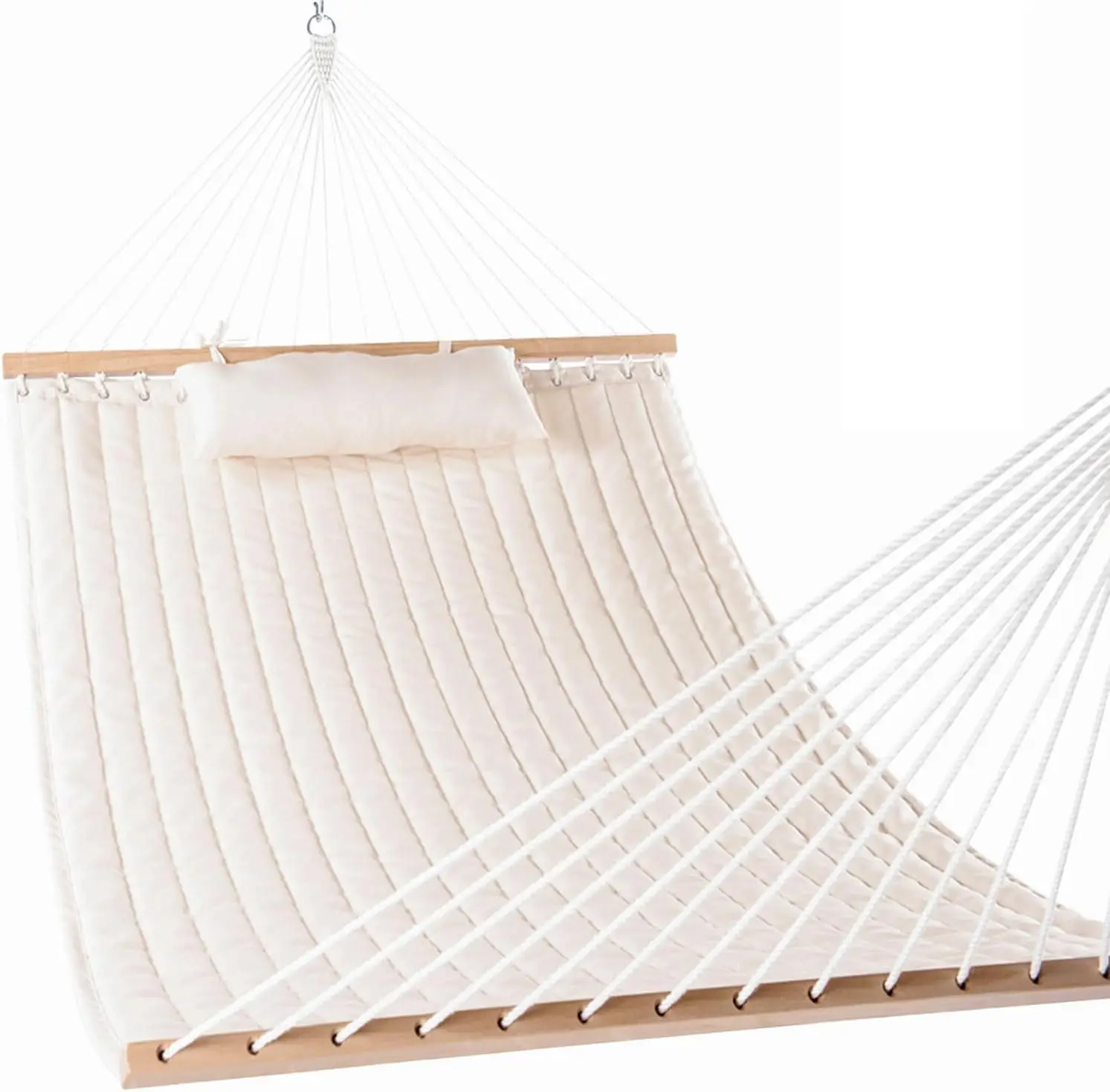
Some systems integrate all these elements, while others use a modular approach that allows you to adapt to different conditions. Our complete camping hammock systems offer integrated solutions that ensure all components work together perfectly to maximize warmth retention.
When properly set up, these components create a continuous thermal envelope around your body, with each element addressing a specific type of heat loss: the underquilt prevents convective and radiative heat loss below, the topquilt handles those same issues above, and together they minimize drafts and air movement that would otherwise carry away your body heat.
Insulation Materials: Comparing Performance in Outdoor Conditions
The materials used in quilted hammock insulation significantly impact performance in various conditions. Understanding these differences helps you choose the right system for your needs.
Down Insulation is known for its exceptional warmth-to-weight ratio and compressibility:
– Typically measured by “fill power” (600-900), with higher numbers indicating better quality
– Extraordinarily lightweight while providing superior warmth
– Compresses incredibly small for efficient packing
– Maintains its loft and insulating properties over many years when properly cared for
– Primary drawback: loses much of its insulating ability when wet and takes time to dry
Synthetic Insulation offers different advantages:
– Continues insulating even when damp or wet
– Dries much faster than down
– Generally more affordable than high-quality down
– Hypoallergenic and easier to care for
– Primary drawbacks: heavier and bulkier than down for equivalent warmth
| Feature | Down Insulation | Synthetic Insulation |
|---|---|---|
| Warmth-to-weight | Excellent | Good |
| Compressibility | Excellent | Moderate |
| Wet performance | Poor | Good to Excellent |
| Durability | Very good with proper care | Good to Very good |
| Cost | Higher | Lower |
| Weight | Lighter | Heavier |
The shell fabric surrounding the insulation is equally important. Most quality quilted hammocks use ripstop nylon with various treatments:
– DWR (Durable Water Repellent) treatments help shed light moisture
– Different fabric weights (measured in denier) balance durability against weight
– Breathability must be balanced with wind resistance
Temperature ratings for hammock insulation systems work similarly to sleeping bag ratings, though they’re often less standardized. A 20°F (-7°C) rated system means most users should stay reasonably comfortable down to that temperature with appropriate clothing.
Our spreader bar hammock sets feature designs that affect how heat distributes around your body, with specific insulation considerations unique to this style.
Maximizing Heat Retention: Setup Techniques and Best Practices
Proper setup is just as important as quality gear when it comes to staying warm in a hammock. Even the best insulation system will underperform if not set up correctly.
Underquilt Installation and Adjustment:
– Hang the underquilt so it makes light contact with the hammock’s underside – not tight against it, but not hanging far below either
– Ensure the underquilt wraps around the sides of the hammock to prevent “edge drafts”
– Use shock cord adjustments to snug the ends around the hammock, creating a draft-free seal
– Check for and eliminate gaps, especially around the shoulders and feet
Effective Topquilt Usage:
– In moderate temperatures, drape the topquilt over you like a blanket for easy temperature regulation
– In colder conditions, use the footbox feature (if available) to seal around your feet
– Tuck the sides of the topquilt beneath you or into the hammock sides to prevent drafts
– Consider a hood or hat if your topquilt doesn’t cover your head
Clothing Strategies:
– Wear a dedicated dry base layer for sleeping – change out of damp hiking clothes
– Use a warm hat to prevent heat loss through your head
– Keep a dedicated pair of dry, warm socks for sleeping
– Layer clothing lightly and evenly rather than having one very thick layer
Creating a Microclimate:
– Position your tarp to block prevailing winds
– Hang the tarp lower in cold or windy conditions to create a smaller, warmer air space
– In winter, consider a “doors closed” tarp configuration that can be sealed on the ends
Additional Warmth Tactics:
– Use a sleeping pad inside the hammock as supplementary insulation (particularly helpful for side-sleepers)
– Consider a “double-layer” hammock that creates a sleeve for a sleeping pad
– Use a hot water bottle (properly sealed) placed near core areas for initial warmth
Following proper hammock installation requirements and safety guidelines ensures not only comfort but optimal thermal efficiency in your setup.
Seasonal Adaptations: Tailoring Your Quilted System for Different Conditions
The beauty of a well-designed quilted hammock system is its adaptability across seasons. With some adjustments, the same basic setup can be modified for comfortable use year-round.
Summer Setups (65°F/18°C and above)
In warm conditions, excessive insulation becomes uncomfortable. Focus on:
– Using a lightweight underquilt or “summer underquilt” with less insulation
– Employing a thin topquilt that can be easily thrown off if too warm
– Setting up with maximum ventilation, including higher tarp positioning
– Considering bug protection as the primary concern rather than heat retention
Shoulder Season Adaptations (40-65°F/4-18°C)
Spring and fall require more attention to insulation while maintaining adaptability:
– Use a medium-weight underquilt that provides more substantial protection
– Layer a lighter topquilt with the option to add a blanket for colder nights
– Position the tarp for weather protection but maintain some airflow
– Pack additional layers to adapt to temperature swings common in these seasons
Winter Configurations (Below 40°F/4°C)
Cold weather demands a comprehensive approach:
– Employ a full-length, winter-rated underquilt with maximum loft
– Use a winter-rated topquilt, potentially with an additional blanket for extremely cold nights
– Set up a full-coverage tarp configuration with minimal gaps
– Add reflective materials beneath the hammock to reflect radiant heat
– Consider a “full winter sock” – a complete fabric surround that creates a secondary barrier
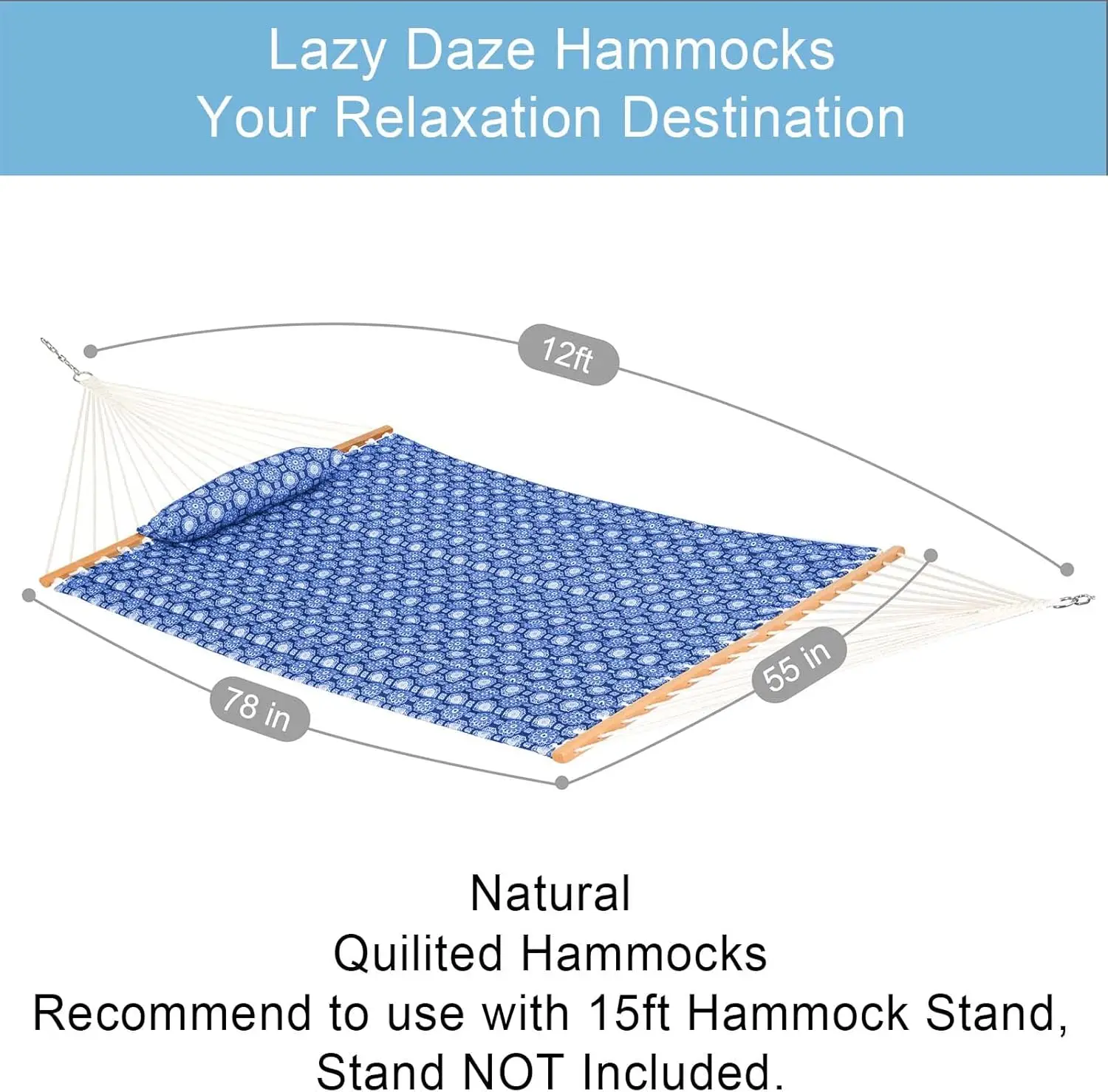
For those wondering if it’s okay to leave hammocks outside, seasonal considerations become even more important. While most hammock systems are designed for temporary setup, understanding weather impacts helps protect your gear.
A modular approach – where you can mix and match components based on conditions – offers the most flexibility. For example, maintaining a core hammock while swapping underquilts of different temperature ratings allows adaptation to changing conditions without purchasing entirely new systems.
Warmth Comparison: How Quilted Hammocks Stack Up Against Other Sleep Systems
When properly outfitted with quality insulation, how do quilted hammocks compare to other outdoor sleeping options? This comparison helps put hammock warmth potential in perspective.
Quilted Hammock Systems vs. Traditional Tent Camping
Quilted Hammock Advantages:
– Gets you completely off the cold, potentially damp ground
– Eliminates the need for finding flat terrain
– Often lighter than comparable tent + sleeping pad + bag combinations
– Typically provides better airflow and condensation management
Traditional Tent Advantages:
– Generally easier to set up and use for beginners
– Provides better protection from extreme winds
– Often less expensive for comparable temperature ratings
– More familiar and conventional design for most campers
Quilted Hammocks vs. Uninsulated Hammocks
The difference is dramatic – an uninsulated hammock can be comfortable down to about 70°F (21°C), while a properly outfitted quilted system can be used well below freezing. This vast performance difference comes from addressing the fundamental physics of heat loss rather than just providing a sleeping platform.
Weight and Packability Considerations
A complete hammock system with insulation typically weighs between 2.5-5 pounds (1.1-2.3 kg), comparable to many quality tent setups. The packed volume varies significantly based on materials, with down systems packing much smaller than synthetic alternatives.
What many outdoor enthusiasts discover is that quilted hammocks offer unmatched comfort beyond just heat retention. The combination of proper support, freedom from pressure points, and consistent warmth creates a sleep experience many find superior to ground sleeping.
Buyer’s Guide: Key Considerations When Choosing a Quilted Hammock System
Finding the right quilted hammock system involves balancing several factors based on your specific needs and usage scenarios.
Integrated vs. Modular Systems
Integrated Systems:
– Offer simpler setup with fewer components to manage
– Ensure compatibility between all elements
– Generally lighter than comparable modular systems
– Limit flexibility for varying conditions
Modular Systems:
– Allow component upgrades over time
– Provide adaptability across seasons by swapping components
– Enable mixing insulation types for different body areas
– Often more cost-effective long-term as you build your system
Quality Indicators to Look For:
- Even, consistent stitching throughout quilted sections
- Reinforced stress points where suspension attaches
- Thoughtfully designed closure systems that prevent drafts
- Temperature rating appropriate for your intended use
- Warranty coverage that reflects manufacturer confidence
Sizing and Fit Considerations:
- Underquilts should be slightly wider than your hammock to wrap the sides
- Length should match or slightly exceed your hammock length
- Weight capacity should comfortably exceed your body weight
- Consider diagonal lay space if you sleep at an angle (most comfortable for many)
Budget Considerations:
High-quality quilted hammock systems represent an investment in comfort and durability. While initially more expensive than basic options, premium systems offer:
– Longer usable lifespan
– Consistent performance in challenging conditions
– Better temperature regulation across seasons
– Superior construction that withstands regular use
For those seeking durable options designed for extended outdoor use, our heavy duty hammock sets provide exceptional durability while maintaining effective heat retention properties.
Classic Wooden Stand Hammock Sets, Heavy Duty Hammock Sets
$1,061.68 Select options This product has multiple variants. The options may be chosen on the product pageHammock Sets with Canopy, Heavy Duty Hammock Sets
$286.31 Select options This product has multiple variants. The options may be chosen on the product pageHeavy Duty Hammock Sets, Wooden Arc Stand Hammock Sets
$878.66 Select options This product has multiple variants. The options may be chosen on the product pageCamping Hammock Sets with Bug Net, Complete Camping Hammock Systems
Price range: $82.73 through $97.96 Select options This product has multiple variants. The options may be chosen on the product page
FAQs: Common Questions About Quilted Hammock Warmth
Are quilted hammocks suitable for winter camping?
Yes, with the right components and setup. A properly outfitted quilted hammock system with appropriate temperature-rated underquilt and topquilt can be comfortable well below freezing. For extreme cold (below 20°F/-7°C), additional considerations like wind protection and supplementary insulation become important.
Do I need both an underquilt and topquilt?
For temperatures below 65°F (18°C), yes. The underquilt addresses the critical issue of insulation compression beneath you, while the topquilt handles heat loss above. In warmer conditions, you might use just an underquilt with a light blanket or sheet on top.
How do I prevent condensation in my hammock system?
Proper ventilation is key. Ensure some airflow through your setup, even in cold conditions. Choose breathable fabrics for your sleep system, avoid sealing the environment completely, and keep wet gear outside your sleep area. In very cold conditions, a small gap at the tarp edges allows moisture to escape rather than condense inside.
What’s the proper care for quilted hammock gear?
Follow manufacturer guidelines for cleaning. Generally, spot cleaning is preferred for minor soiling. For deeper cleaning, use appropriate technical cleaners (especially for down) and gentle cycles. Always fully dry insulation before storage, and store loosely in a breathable bag rather than compressed.
Can I use emergency alternatives if I don’t have proper quilts?
In a pinch, closed-cell foam pads inside the hammock provide some insulation, though less effectively than a proper underquilt. Emergency blankets (mylar) can be wrapped around the hammock exterior to reflect some heat. These are temporary solutions only and don’t replace proper insulation for regular use.
Selecting perfect hammock placement in terms of wind protection and natural shelter can significantly enhance the performance of your insulation system, especially in challenging conditions.

